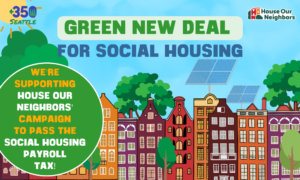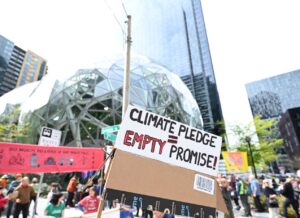Three bills currently before the Washington Legislature propose to update the state’s climate pollution reduction limits. One is based on the best climate science, while the others are unfortunately based on outdated science, and allow dangerous levels of carbon dioxide emissions.
At a global level, allowing higher emissions will cause the collapse of ocean life and dramatic sea level rise. At a state level, outdated science means policy actions to halt climate disruption will fall far short of what is needed to avert severe impacts and economic losses in Washington, including collapse of the shellfish industry and elimination of current port facilities.
The bills are:
- HB 1372, introduced by Rep. Jessyn Farrell, would update the targets in line with science developed to return the atmosphere to 350 parts per million (ppm) carbon dioxide by 2100, from its current level of 405 ppm. holding global warming to 1° C/1.8° F.
- HB 1144, introduced by Rep. Joe Fitzgibbon, would use targets developed by the state Department of Ecology, which are associated with a rise to 450 ppm and global warming of 2° C/3.6° F.
- SB 5421, introduced by Sen. Maralyn Chase, would upgrade targets, but to a lesser degree than the Fitzgibbon Bill.
The table below contrast climate pollution reduction targets:
| HB 1372 | HB 1144 | SB 5421 | |
| By 2020 | At least 10% below 1990 levels | 1990 levels | 1990 levels |
| By 2035 | At least 68% below 1990 levels | 40% below 1990 levels | 40% below 1990 levels |
| By 2050 | At least 91% below 1990 levels | 80% below 1990 levels | 50% below 1990 levels |
Dr. Pushker A. Kharecha of Columbia University NASA Goddard Institute for Space Studies, says, “Arguably the most important chemical impact of higher atmospheric CO2 is increasing ocean acidification, which could lead to major disruptions to ocean biota and ecosystems (including complete collapses), most notably coral reefs and carbonate-shelled organisms like shellfish.”
The Washington State Blue Ribbon Panel on Ocean Acidification reports that at levels near 450 ppm, more than half of the marine waters in Washington state will be corrosive to oysters, clams, scallops, mussels, crabs, abalone, and pteropods, barnacles, sea urchins, sand dollars, sea stars, sea cucumbers, and crabs, meaning that these species could be eradicated from Washington waters. Levels of 450 ppm could result in the elimination of 30% of Puget Sound’s marine species.
The 450 ppm/2°C target could lead to sea levels over 30 feet higher, with disastrous consequences for coastal communities, studies cited by Dr. Kharecha show. At that level, the current port sites of Seattle and Tacoma as well as many shoreline neighborhoods would be inundated. The Department of Ecology recognizes that targeting emission reductions to 450 ppm only offers a 50% chance of holding below 2° C, and temperatures have already risen 0.4°F in the last three years. That is a key reason why limits based on the 350 ppm target are crucial.
HB 1372 would also enact needed policy changes that HB 1144 would not:
- Require the Department of Ecology to adopt rules, policies and legislation that meet the targets, and track and annually report progress.
- Implement a carbon sequestration plan by Dec. 1, 2018.
- Remove the exemption on burning biomass from emissions limits.
- Update state agency emission reduction requirements to align with best science.
- Require the state to inventory emissions based on consumption, including imports into the state.
350 Seattle calls on the 2017 Legislature to enact science-based climate pollution limits that return the atmosphere to 350 ppm, in order to ensure a healthy environment for ourselves and for our children. The only bill that currently meets that test is HB 1372.








